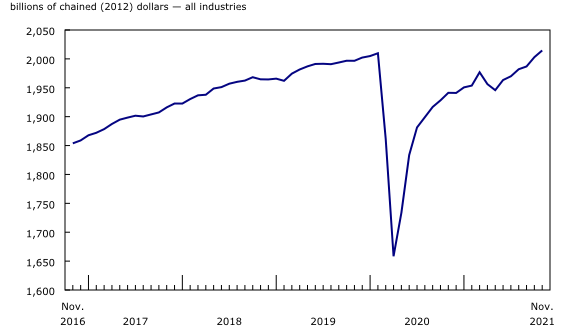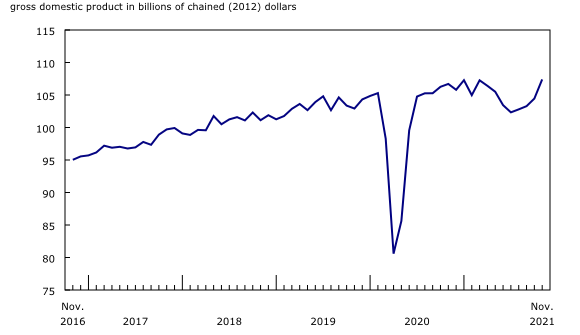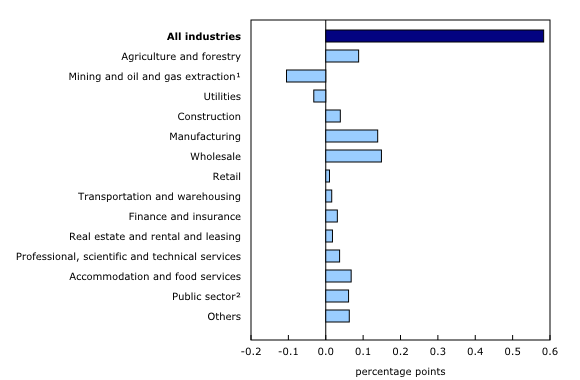Gross domestic product by industry, November 2021
Archived Content
Information identified as archived is provided for reference, research or recordkeeping purposes. It is not subject to the Government of Canada Web Standards and has not been altered or updated since it was archived. Please "contact us" to request a format other than those available.
Released: 2022-02-01
November 2021
0.6% 
(monthly change)
Real gross domestic product (GDP) rose 0.6% in November, following 0.8% growth in October. Increases across almost all sectors contributed to the sixth consecutive monthly expansion, bringing the level of real GDP 0.2% above its February 2020 level, prior to the COVID-19 pandemic.
Both services-producing (+0.6%) and goods-producing (+0.5%) industries were up, as 17 of 20 industrial sectors posted increases in November.
Advance information indicates that real GDP for December was essentially unchanged. Widespread increases led by the manufacturing, agriculture, forestry, fishing and hunting, utilities and wholesale trade sectors were offset by declines in the accommodation and food services, mining, quarrying, and oil and gas extraction and retail trade sectors. This advance information for real GDP by industry indicates a 1.6% uptick in the fourth quarter of 2021 and a rebound of 4.9% in the year following the pandemic-induced decline observed in 2020. Given their preliminary nature, these estimates will be updated on March 1, 2022 with the release of the official GDP data for December and the fourth quarter of 2021.
Wholesale trade keeps growing
The wholesale trade sector grew 2.8% in November, the largest monthly growth rate since July 2020 and the fourth consecutive month of growth, as eight of the nine subsectors contributed to the increase.
Building material and supplies wholesaling contributed the most to the growth, with a 7.0% increase in November, benefiting from heightened demand for products internationally. Machinery, equipment and supplies wholesaling rose 2.9%, driven primarily by activity in the construction, forestry, mining, and industrial machinery industry. Only farm product wholesaling (-7.2%) was down as exports of products through a main hub on the West Coast, the Port of Vancouver, were impacted by record floods that hit British Columbia in November.
Manufacturing grows
The manufacturing sector grew 1.4% in November, the third increase in four months, driven by broad-based growth as both durable-goods and non-durable goods manufacturing were up.
Durable-goods manufacturing rose 1.8% as 7 of 10 subsectors grew in November. Transportation equipment manufacturing (+3.6%) led the growth as the majority of industries were up. Increased output at a number of assembly plants, and a restart after a lengthy delay at others, contributed to the growth in motor vehicle (+9.2%) and motor vehicle parts (+6.4%) manufacturing. Miscellaneous manufacturing (+5.6%) and non-metallic mineral product manufacturing (+4.0%) were up, while computer and electronic products manufacturing (-1.7%) and machinery manufacturing (-0.6%) offset some of the growth.
Non-durable goods manufacturing increased 1.0%, led by a 6.8% rise in petroleum and coal products as output at petroleum refineries grew, coinciding with higher exports of refined petroleum energy products. Chemical (+2.2%), beverage and tobacco (+2.1%) and textile, clothing and leather (+4.0%) manufacturing further contributed to the growth, while plastics and rubber products (-3.1%), printing and related support activities (-4.8%) and paper manufacturing (-2.8%) declined.
Mining, quarrying, and oil and gas extraction declines
Mining, quarrying, and oil and gas extraction decreased 1.8% in November, down for the first time in seven months, as all subsectors contracted.
Oil and gas extraction decreased 2.5% in November, after reaching the pre-pandemic level of production in October. Oil sands extraction contracted 4.3% in November as crude bitumen and synthetic oil production decreased in Alberta. Oil and gas extraction (except oil sands) edged up 0.1% as a decline in crude petroleum extraction was offset by higher natural gas extraction.
The mining and quarrying (except oil and gas) subsector contracted 0.2% in November as lower coal mining offset growth in metal ore, and non-metallic mineral mining and quarrying.
Coal mining fell 17.2% in November as flooding in British Columbia disrupted exports through Vancouver marine terminals. Metal ore mining rose 2.8% on the strength of higher copper, nickel, lead and zinc mining (+7.0%) and an increase in potash mining (+2.6%) contributed the most to a 2.0% growth in non-metallic mineral mining and quarrying.
Support activities for mining, and oil and gas extraction were down 2.0% in November, after six consecutive months of growth, with drilling services contributing the most to the decline.
Accommodation and food services grow
Accommodation and food services rose 3.4% in November, following two consecutive months of decline, as both subsectors expanded.
Accommodation services posted a sixth consecutive increase, expanding 7.1% in November, as all industries comprising the subsector were up, led by higher activity in traveller accommodation services.
Food services and drinking places rose 2.0% in November, following two consecutive months of decline, as all forms of restaurants experienced higher levels of activity, benefitting from the lifting of capacity limits in restaurants and bars in Ontario and Quebec.
Public sector grows
The public sector increased 0.3% in November as all sectors grew.
Health care and social assistance rose 0.3% as gains in ambulatory health care services (+0.8%), nursing and residential care facilities (+0.2%) and social assistance (+0.1%) were tempered by decreases in hospitals (-0.2%).
Public administration expanded 0.3% in November with output of all levels of government increasing.
Educational services increased 0.3% in November, with the majority of industries up, led by universities (+0.7%) and elementary and secondary schools (+0.1%).
Construction grows
The construction sector expanded 0.5% in November, up for the third time in four months, as all forms of construction activity increased.
Engineering and other construction activities rose 1.0% in November, the largest monthly gain since April. Repair construction was up 0.5%, as both the residential and non-residential segments contributed to the gain.
Residential building construction was up 0.2% in November as growth in home alterations and improvements more than offset declines in all forms of new residential dwellings construction.
Non-residential building construction rose for the fifth month in a row, up 0.5% in November as an increase in institutional construction more than offset declines in industrial and commercial buildings construction.
Other industries
Agriculture, forestry, fishing and hunting rose 5.5% in November, led by crop production. Crop production (except cannabis) rose 11.0% as farmers continued to prepare for the next crop year.
Professional, scientific and technical services grew 0.5% in November, up for the seventh month in a row, led by computer systems design and related services (+1.3%) and architectural, engineering and related services (+0.7%).
Finance and insurance rose 0.4% in November, up for the sixth month in a row. The emergence of the COVID-19 Omicron variant and uncertainty with respect to its severity pushed investors to move funds into safer assets, creating atypically high trading activity levels in November. This higher activity, along with an increase in households' mortgage borrowing, contributed to growth in financial investment services (+1.1%) and depository credit intermediation and monetary authorities (+0.4%).
The arts, entertainment and recreation sector expanded 5.4% in November as all subsectors were up, benefiting from continued easing of capacity limits on large group and indoor gatherings. Performing arts, sports and heritage institutions (+9.2%) led the growth, as higher attendance at major leagues' sporting events was boosted by two CONCACAF World Cup 2022 qualifying soccer games played in Edmonton. Amusement, gambling and recreation industries increased 2.8% as gyms, amusement parks and other types of establishments were open at full capacity in many parts of the country.
Utilities contracted 1.5% in November as lower electric power generation, transmission and distribution (-1.8%) and natural gas distribution (-0.6%) contributed to the decline.
The real estate rental and leasing sector edged up 0.1% as declines in activity at the offices of real estate agents and brokers (-0.8%) and lessors of non-financial intangible assets (-1.7%) were more than offset by increases in other industries comprising the sector.
Retail trade rose 0.2% in November with the 12 subsectors evenly split between increases and decreases. Gasoline stations (+3.8%), clothing and clothing accessories stores (+2.5%) and building material and garden equipment and supplies dealers (+2.6%) led the growth. Sporting goods, hobby, book and music stores (-8.6%) and electronic and appliance stores (-4.8%) were the largest detractors to growth.
Sustainable development goals
On January 1, 2016, the world officially began implementing the 2030 Agenda for Sustainable Development—the United Nations' transformative plan of action that addresses urgent global challenges over the following 15 years. The plan is based on 17 specific sustainable development goals.
The release on gross domestic product by industry is an example of how Statistics Canada supports global sustainable development goal reporting. This release will be used to help measure the following goal:

Note to readers
Monthly data on gross domestic product (GDP) by industry at basic prices are chained volume estimates with 2012 as the reference year. This means that the data for each industry and each aggregate are obtained from a chained volume index multiplied by the industry's value added in 2012. The monthly data are benchmarked to annually chained Fisher volume indexes of GDP obtained from the constant-price supply and use tables (SUTs) up to the latest SUT year (2018).
For the period starting in January 2019, data are derived by chaining a fixed-weight Laspeyres volume index to the prior period. The fixed weights are 2018 industry prices.
This approach makes the monthly GDP by industry data more comparable with expenditure-based GDP data, which are chained quarterly.
All data in this release are seasonally adjusted. For information on seasonal adjustment, see Seasonally adjusted data – Frequently asked questions.
An advance estimate of industrial production for December 2021 is available upon request.
For more information on GDP, see the video "What is Gross Domestic Product (GDP)? "
Revisions
With this release of monthly GDP by industry, revisions have been made back to January 2021.
Each month, newly available administrative and survey data from various industries in the economy are integrated, resulting in statistical revisions. Updated and revised administrative data (including taxation statistics), new information provided by respondents to industry surveys, and standard changes to seasonal adjustment calculations are incorporated with each release.
The advance estimate of real GDP by industry for November, released on December 23, 2021, was revised from an increase of 0.3% to an increase of 0.6% with today's official release.
This revision stems, in part, from a smaller than anticipated decline in mining, quarrying, and oil and gas extraction, as well as stronger growth than initially estimated in agriculture, forestry, fishing and hunting.
Real-time table
Real-time table 36-10-0491-01 will be updated on February 14, 2022.
Next release
Data on GDP by industry for December 2021 will be released on March 1, 2022.
Products
The User Guide: Canadian System of Macroeconomic Accounts (13-606-G) is available.
The Methodological Guide: Canadian System of Macroeconomic Accounts (13-607-X) is also available.
The Economic accounts statistics portal, accessible from the Subjects module of the Statistics Canada website, features an up-to-date portrait of national and provincial economies and their structure.
Contact information
For more information, contact us (toll-free 1-800-263-1136; 514-283-8300; infostats@statcan.gc.ca).
To enquire about the concepts, methods or data quality of this release, contact Ederne Victor (statcan.mediahotline-ligneinfomedias.statcan@statcan.gc.ca), Industry Accounts Division.
- Date modified:




